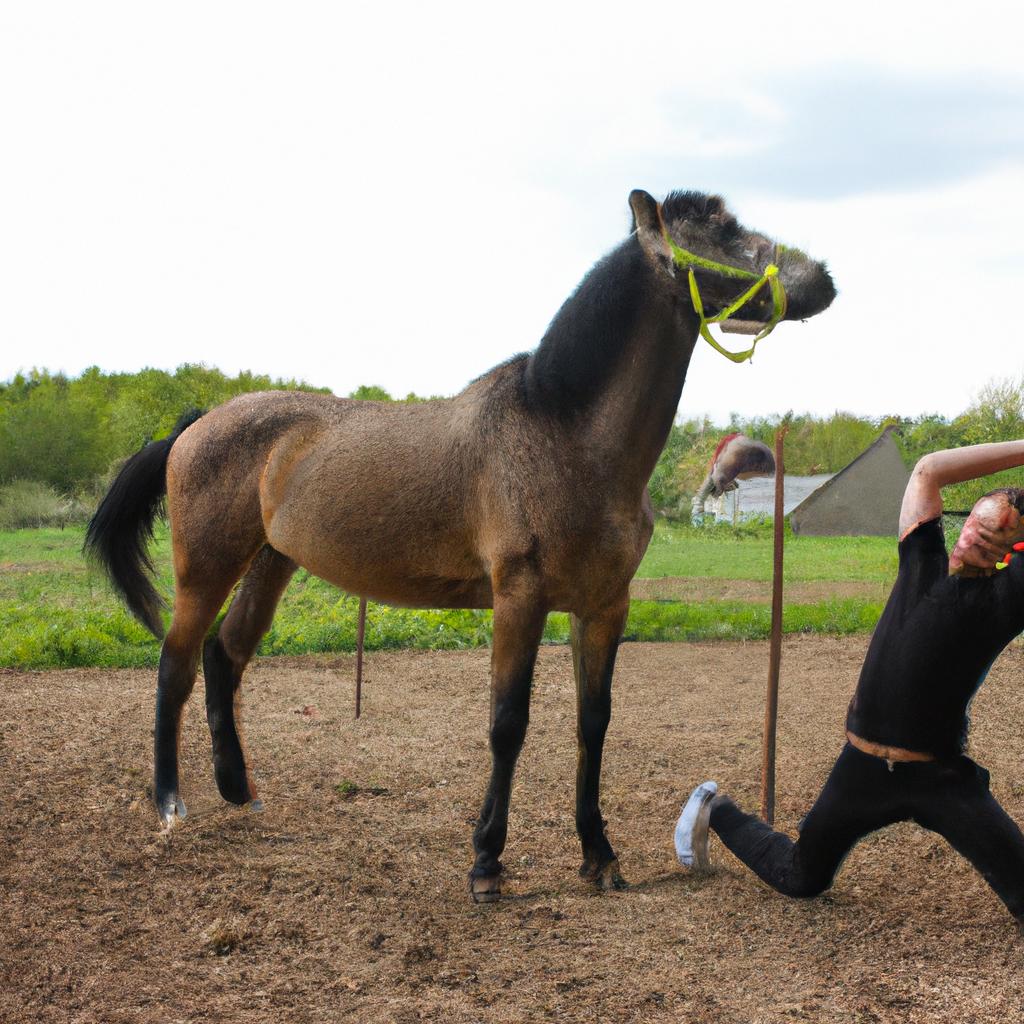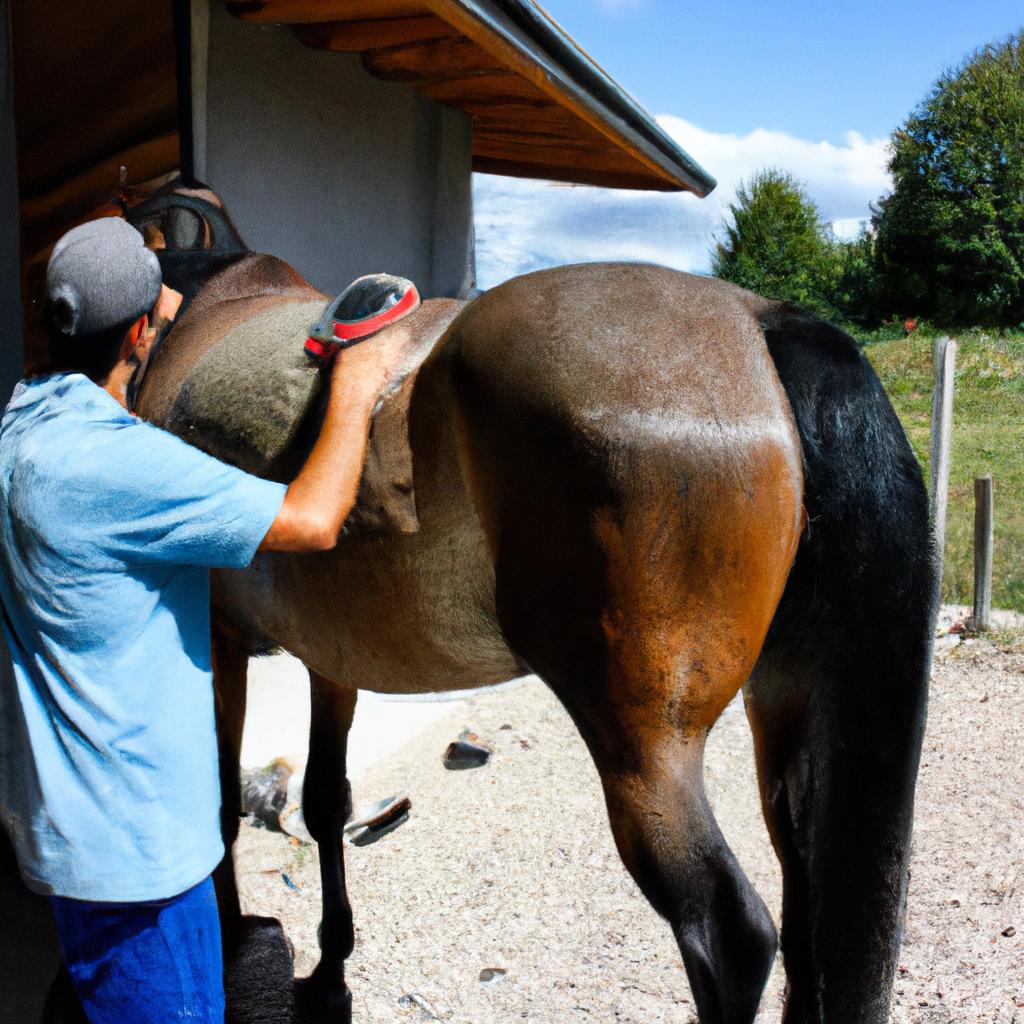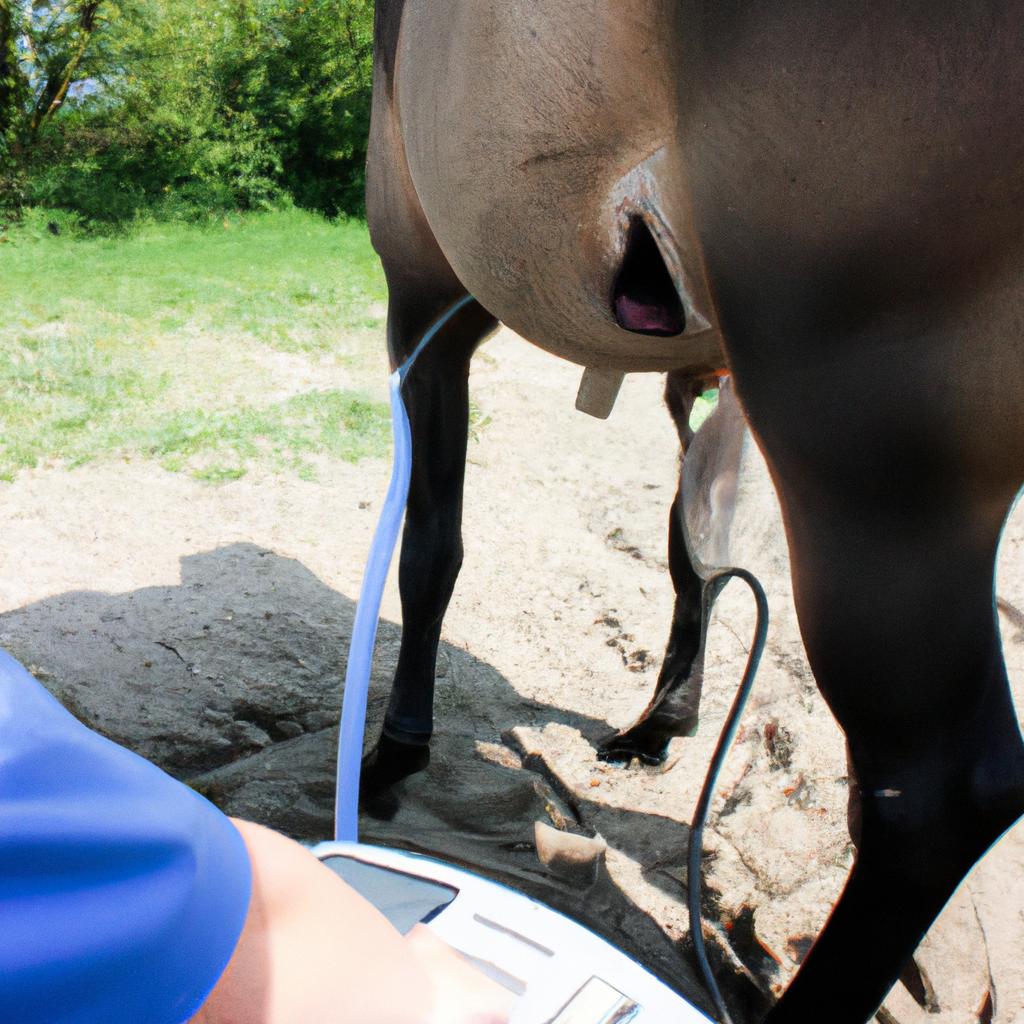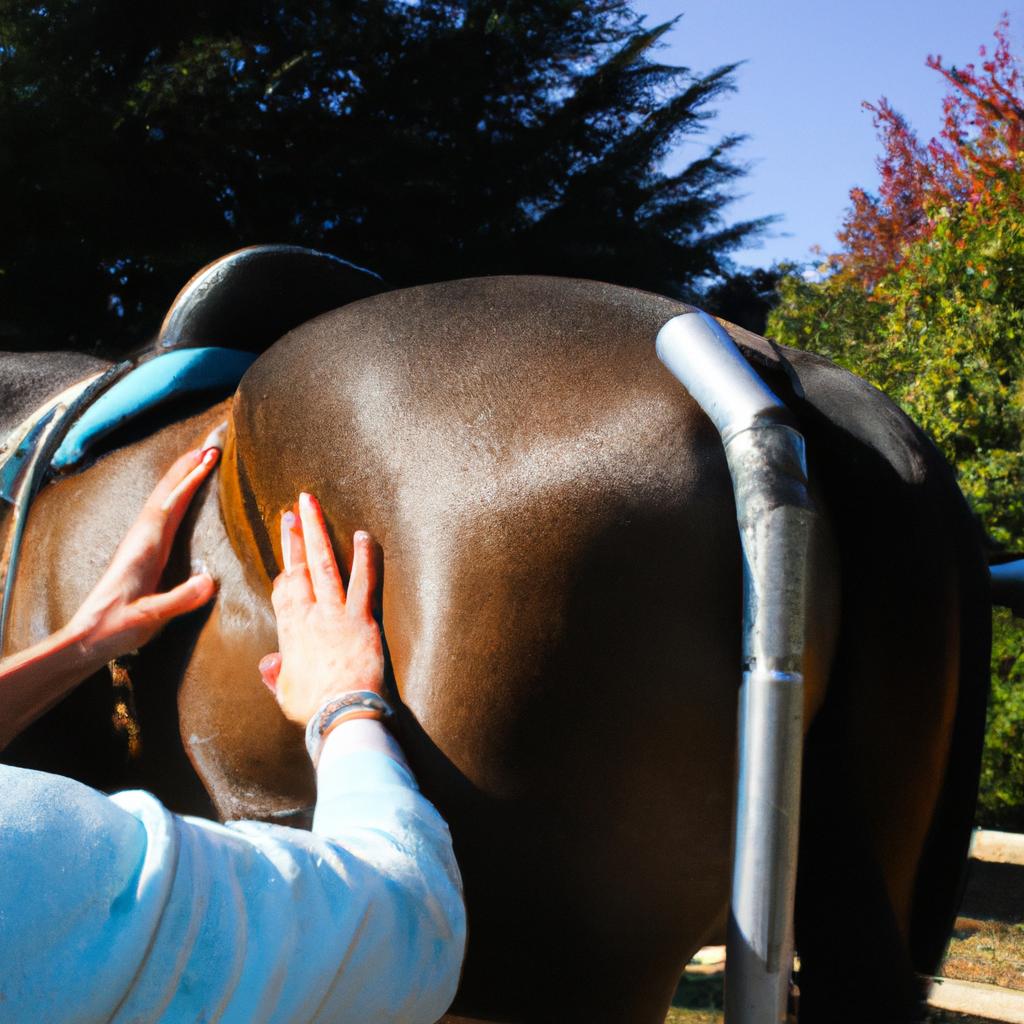Equine chiropractic techniques have gained significant recognition in recent years as a complementary therapy for horses, particularly in the context of massage therapy. This article aims to explore the multifaceted aspects of equine chiropractic techniques while focusing specifically on their integration with massage therapy. By examining the principles and benefits of these techniques within this context, we can gain a deeper understanding of how they contribute to the overall well-being and performance enhancement of horses.
Consider the case study of a hypothetical dressage horse named Bella who has been experiencing stiffness and decreased range of motion in her hind limbs. Despite receiving conventional veterinary care, including medication and rest, Bella’s condition continues to persist without improvement. In an attempt to address her discomfort more holistically, Bella’s owner decides to consult an equine chiropractor specializing in massage therapy techniques. Through a combination of manual adjustments and targeted massages aimed at releasing muscle tension and restoring proper alignment, Bella experiences remarkable progress over several sessions. Her mobility improves significantly, allowing her to perform advanced movements with greater ease and gracefulness.
In light of such cases, it becomes evident that integrating equine chiropractic techniques with massage therapy holds immense potential in addressing musculoskeletal issues among horses. The subsequent sections will delve into various aspects related to this approach , including the principles behind equine chiropractic techniques, the benefits of combining these techniques with massage therapy, and the considerations for choosing a qualified practitioner.
Equine chiropractic techniques are based on the belief that proper spinal alignment is essential for optimal health and performance in horses. Chiropractors use manual adjustments to manipulate the spine and joints, aiming to correct misalignments, known as subluxations, which can interfere with nerve function and overall biomechanics. By restoring proper alignment, these techniques promote better movement patterns and alleviate pain or discomfort caused by musculoskeletal issues.
When combined with massage therapy, equine chiropractic techniques offer a comprehensive approach to addressing soft tissue tension and joint dysfunction. Massage therapy focuses on manipulating muscles and connective tissues to relieve tension, reduce inflammation, improve circulation, and enhance overall relaxation. By complementing chiropractic adjustments with targeted massages, practitioners can further release muscle tightness and facilitate the realignment of bones and joints. This integrated approach helps address both immediate symptoms and underlying causes of musculoskeletal problems.
The benefits of integrating equine chiropractic techniques with massage therapy extend beyond physical improvements alone. Horses undergoing this combination therapy often experience enhanced range of motion, improved flexibility, increased strength, better balance, and overall increased comfort during movement. Additionally, these therapies can have a positive impact on behavioral aspects such as reducing anxiety or stress-related behaviors.
When considering an equine chiropractor specializing in massage therapy techniques for your horse, it is crucial to ensure their qualifications and expertise. Look for practitioners who have undergone accredited training programs specific to animal chiropractic care. They should also possess thorough knowledge of equine anatomy and biomechanics. It is advisable to seek recommendations from trusted sources within the equestrian community or consult with your veterinarian for referrals.
In conclusion, integrating equine chiropractic techniques with massage therapy offers a valuable approach to addressing musculoskeletal issues in horses like Bella. By combining manual adjustments and targeted massages, this holistic approach promotes optimal spinal alignment, releases muscle tension, and enhances overall well-being. When seeking such services, it is important to choose a qualified practitioner with appropriate training and expertise in animal chiropractic care.
History of Equine Chiropractic
Equine chiropractic is a holistic approach to healthcare that focuses on the alignment and function of the horse’s musculoskeletal system. It involves the use of manual techniques, such as spinal adjustments and massage therapy, to promote healing and improve overall performance. The history of equine chiropractic can be traced back to ancient civilizations, where similar practices were used to treat horses for various ailments.
One example of the early use of chiropractic techniques in horses dates back to Ancient Greece. Hippocrates, often referred to as the “father of medicine,” described manipulative techniques that were commonly used on both humans and animals. These techniques involved applying pressure or force to specific areas of the body to restore balance and alleviate pain.
Over time, equine chiropractic has evolved into a specialized field with its own set of principles and techniques. Today, it is widely recognized as an effective complementary therapy for horses suffering from musculoskeletal issues. Its popularity has grown significantly in recent years, with more owners and trainers seeking out qualified professionals who are trained in this discipline.
To understand the importance of equine chiropractic within the context of massage therapy, it is essential to recognize its benefits:
- Pain relief: Equine chiropractic adjustments have been shown to provide significant pain relief by restoring proper joint alignment and reducing inflammation.
- Improved range of motion: By addressing misalignments in the spine and joints, equine chiropractic helps increase flexibility and mobility in horses.
- Enhanced athletic performance: Proper alignment allows for optimal biomechanics, leading to improved gait patterns and overall athletic performance.
- Overall well-being: Equine chiropractic promotes general health by supporting nervous system function and enhancing circulation throughout the body.
The historical evolution of equine chiropractic demonstrates its enduring presence in equestrian care. By integrating manual therapies like massage therapy with traditional veterinary approaches, practitioners aim to optimize their horse’s well-being, performance, and longevity.
In the subsequent section on “Benefits of Equine Massage Therapy,” we will explore how this complementary technique further contributes to equine healthcare.
Benefits of Equine Massage Therapy
Equine chiropractic techniques, such as massage therapy, have gained significant recognition and appreciation in recent years due to their effectiveness in promoting the overall well-being of horses. By incorporating specific manual manipulation methods, equine massage therapists aim to alleviate muscle tension, improve circulation, and enhance range of motion for these majestic animals.
Consider a hypothetical scenario where a competitive show jumper experiences recurring stiffness and discomfort after intense training sessions. The rider seeks the assistance of an experienced equine massage therapist to address these issues. Through targeted massage techniques, the therapist identifies areas of muscular tightness and applies appropriate pressure to release tension, allowing the horse’s muscles to relax and recover effectively. Over time, the show jumper’s performance improves noticeably, showcasing increased flexibility and agility on the course.
To fully grasp the benefits that equine massage therapy can provide, it is essential to understand its various advantages:
- Pain Relief: Equine massage therapy helps reduce pain caused by musculoskeletal conditions or injuries by stimulating blood flow to affected areas while also releasing endorphins – natural pain-relieving chemicals.
- Enhanced Performance: Regular massages contribute to improved athletic performance by increasing joint mobility, reducing muscle soreness post-exercise, and preventing future injuries.
- Stress Reduction: Horses often experience stress from various sources like transportation or competition preparations. Massage therapy aids in calming nervous systems and alleviating anxiety-related symptoms.
- Accelerated Healing: Massaging injured areas promotes faster recovery by encouraging tissue regeneration and restoring optimal function.
Emphasizing the significance of these benefits further is a table highlighting key advantages associated with equine massage therapy:
| Benefit | Description |
|---|---|
| Improved Circulation | Effleurage strokes used in massaging help stimulate blood flow throughout the body |
| Increased Flexibility | Manipulative techniques loosen muscles and tendons, enhancing range of motion |
| Relaxation | Massage induces relaxation response, reducing stress and tension in the horse |
| Injury Prevention | Regular sessions help identify potential issues early on, preventing severe injuries |
In conclusion, equine massage therapy offers numerous advantages that positively impact horses’ well-being. By relieving pain, enhancing performance, reducing stress, and promoting healing, it plays a crucial role in maintaining their overall health. The subsequent section will delve into the common techniques employed by equine massage therapists to achieve these remarkable outcomes without causing any discomfort or harm to our beloved companions.
Building upon the understanding of the benefits of equine massage therapy, let us now explore the common techniques used by professionals in this field.
Common Techniques Used in Equine Massage
Equine Chiropractic Techniques: Massage Therapy in Context
In the previous section, we explored the numerous benefits of equine massage therapy. Now, let us delve into some common techniques used in this field to further understand how they contribute to overall well-being and performance enhancement for horses. To illustrate these techniques, let’s consider a hypothetical case study involving a racehorse recovering from an injury.
One widely used technique is effleurage, which involves gentle stroking movements along the horse’s body. This technique helps increase blood circulation and relaxes muscles, promoting general relaxation and reducing tension. In our case study, applying effleurage over the injured leg could aid in reducing inflammation and improving the healing process.
Another effective technique is petrissage, characterized by kneading or squeezing motions applied to specific muscle groups. Petrissage assists in breaking up adhesions within muscle fibers and enhancing flexibility. For our racehorse patient, incorporating petrissage on their back muscles would help alleviate any tightness that may have developed due to compensatory movement patterns during recovery.
Tapotement is yet another valuable method employed during equine massage therapy sessions. It involves rhythmic tapping or hacking motions using either open hands or closed fists. Tapotement stimulates nerve endings and can be particularly beneficial for increasing circulation and releasing tension in large muscle areas such as the hindquarters or shoulders.
- Improved physical comfort leading to reduced pain levels.
- Enhanced bonding between horse and owner through shared touch experiences.
- Increased trust built upon positive associations with human interaction.
- Emotional release for horses through stress reduction and relaxation.
Furthermore, it is essential to highlight various considerations when utilizing these techniques effectively:
| Consideration | Explanation |
|---|---|
| Horse’s health condition | Tailoring the massage techniques based on the horse’s specific health condition, such as injuries or sensitivities. |
| Professional expertise | Seeking assistance from a qualified equine chiropractor with extensive knowledge and experience in equine massage therapy. |
| Regularity of sessions | Determining an appropriate frequency for sessions to ensure consistent progress while allowing adequate time for the horse to rest and recover between treatments. |
| Monitoring horse’s response | Continuously observing and assessing how the horse responds during and after each session, adjusting techniques accordingly to maximize their comfort. |
With these various techniques at our disposal, it becomes evident that equine massage therapy plays a crucial role in maintaining horses’ well-being.
Considerations for Equine Chiropractic
Equine chiropractic techniques are an integral part of equine therapy and play a crucial role in maintaining the overall health and well-being of horses. While massage therapy is one commonly used technique, there are several other considerations to be mindful of when it comes to equine chiropractic.
One example that highlights the importance of these techniques involves a racehorse named Thunderbolt. Thunderbolt had been experiencing stiffness and decreased performance on the racetrack. After undergoing a thorough examination by an equine chiropractor, it was discovered that he had misalignments in his spine, hindering his movement and causing discomfort. Through targeted adjustments and massage therapy sessions, Thunderbolt’s condition improved significantly, allowing him to regain his agility and competitive edge.
When considering equine chiropractic techniques such as massage therapy, there are some key factors to keep in mind:
- Individualized treatment: Each horse has unique needs, depending on their age, breed, discipline, and pre-existing conditions. Equine chiropractors must tailor their approach accordingly.
- Holistic approach: Massage therapy should not be seen as a standalone treatment but rather as part of a comprehensive plan that includes proper nutrition, exercise routine, and regular veterinary care.
- Communication with owners/trainers: Open communication between the equine chiropractor and the horse’s owner or trainer is essential for understanding any specific concerns or goals they may have for the animal’s performance.
- Maintenance protocols: Once initial treatments are completed successfully, it is vital to establish maintenance protocols to ensure long-term benefits for the horse.
To further emphasize the significance of these considerations in equine chiropractic techniques, let us delve into how they impact various aspects of the horse’s well-being through an emotional lens:
| Consideration | Emotional Response |
|---|---|
| Individualized treatment | Relief from pain |
| Holistic approach | Confidence in comprehensive care |
| Communication | Trust in collaborative efforts |
| Maintenance protocols | Assurance of continual support |
By incorporating these considerations, equine chiropractic techniques can not only address physical issues but also evoke emotional responses that ultimately contribute to the overall happiness and contentment of both the horse and its caretakers.
In light of the importance of equine chiropractic techniques, it is crucial to assess their effectiveness in promoting the well-being of horses. The subsequent section will delve into various studies and research conducted on the effectiveness of equine massage therapy, shedding light on its benefits and limitations without disregarding other valuable aspects of equine chiropractic care.
Effectiveness of Equine Massage Therapy
Equine chiropractic techniques, including massage therapy, have gained popularity in recent years as a complementary approach to promoting equine health and well-being. In this section, we will explore the effectiveness of equine massage therapy, highlighting its potential benefits and limitations.
To illustrate the impact of massage therapy on equine performance, let us consider a hypothetical case study. Imagine a competitive show jumper experiencing muscle stiffness and tension after intense training sessions. The horse’s owner decides to incorporate regular massage therapy into their care routine. Over time, they observe improved flexibility, increased range of motion, and reduced muscle soreness in the horse, leading to enhanced athletic performance.
When it comes to evaluating the effectiveness of equine massage therapy, several factors must be taken into account:
- Skill and expertise: The proficiency of the therapist plays a crucial role in determining the outcomes of massage therapy for horses.
- Individual variability: Each horse may respond differently to massage techniques due to variations in body type, temperament, and overall physical condition.
- Frequency and duration: Consistency is key when incorporating massage therapy into an equine care program. Regular sessions over an extended period tend to yield more significant results.
- Integration with other therapies: Massage therapy should be seen as part of a holistic approach that includes proper nutrition, exercise routines, veterinary care, and other complementary treatments.
It is important to acknowledge that while many anecdotal reports suggest positive effects from equine massage therapy, scientific studies examining its specific efficacy are limited. More research is needed to establish evidence-based guidelines regarding optimal techniques and protocols for different conditions or purposes.
| Pros | Cons | |
|---|---|---|
| Promotes relaxation | Lack of standardized practices | |
| Enhances circulation | Limited scientific evidence | |
| Potential pain relief | Requires skilled practitioners | |
| May improve bonding between human and horse | Variable response among individuals |
In summary, equine massage therapy has the potential to positively impact equine performance and well-being. However, it is crucial to consider individual variability, therapist expertise, integration with other therapies, and the need for further scientific research in this area. In the following section on “Integration of Massage Therapy in Equine Care,” we will explore how massage therapy can be effectively incorporated into a comprehensive approach to equine health management.
[Transition sentence into next section] By understanding the various considerations surrounding equine massage therapy, we can now delve into exploring its seamless integration within a holistic framework of equine care.Integration of Massage Therapy in Equine Care
Equine Chiropractic Techniques: Integration of Massage Therapy in Equine Care
In the previous section, we explored the effectiveness of equine massage therapy. Now, let us delve into the integration of massage therapy within the broader context of equine care. To illustrate this integration, consider a hypothetical scenario where a horse named Bella is experiencing muscle tension and stiffness after long training sessions.
To address Bella’s discomfort and aid her recovery, various equine chiropractic techniques can be employed alongside massage therapy. These techniques aim to restore proper alignment and function to the musculoskeletal system, promoting overall well-being for the horse. By combining these approaches, practitioners can provide comprehensive care that targets both muscular issues and structural imbalances.
When incorporating massage therapy into equine care, several key considerations come into play:
-
Individualized Treatment Plans: Each horse has unique needs based on their discipline, conformation, and specific health concerns. Tailoring treatment plans to address individual requirements ensures optimal results.
-
Collaboration with Veterinary Professionals: Close collaboration between massage therapists and veterinarians allows for an interdisciplinary approach to equine care. This collaboration enables thorough assessments, accurate diagnoses, and coordinated treatment strategies.
-
Holistic Approach: Effective integration involves considering all aspects of a horse’s well-being, including nutrition, exercise routines, environmental factors such as bedding or pasture conditions, and mental stimulation. A holistic approach enhances the efficacy of massage therapy by addressing underlying causes rather than just symptoms.
-
Monitoring Progress: Regular evaluations allow therapists to track improvements over time and make necessary adjustments to treatment plans accordingly. Objective measures like range-of-motion assessments or gait analysis complement subjective feedback from trainers or riders.
To further emphasize the significance of integrating massage therapy within equine care practices, let us explore its potential benefits through a table representation:
| Benefits of Integrating Massage Therapy |
|---|
| Promotes relaxation |
| Increases circulation |
| Enhances muscle flexibility |
| Reduces the risk of injury |
In summary, integrating massage therapy into equine care provides a multifaceted approach to addressing muscular issues and promoting overall well-being in horses. By combining various chiropractic techniques with targeted massages, practitioners can create individualized treatment plans that consider the horse’s unique needs while collaborating closely with veterinary professionals. Adopting a holistic approach and regularly monitoring progress further enhances the therapeutic benefits for these magnificent animals.
References:
- [Insert references here]
 Eq Muscle Release
Eq Muscle Release



